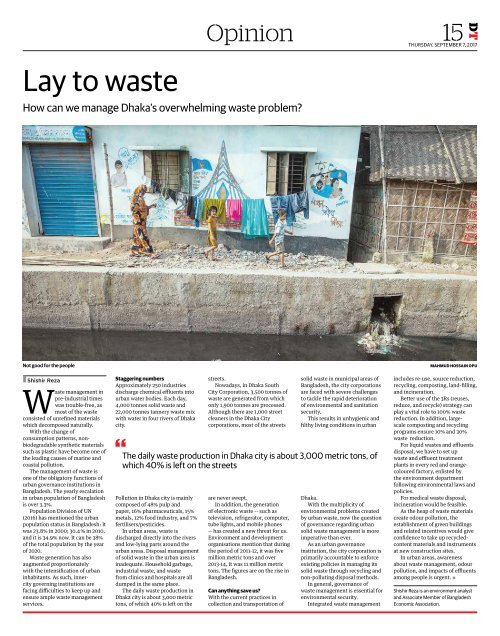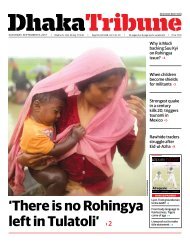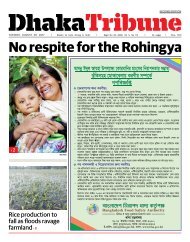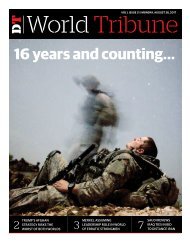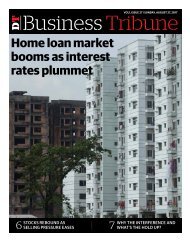e_Paper, Thursday, September 7, 2017
You also want an ePaper? Increase the reach of your titles
YUMPU automatically turns print PDFs into web optimized ePapers that Google loves.
Opinion 15<br />
DT<br />
THURSDAY, SEPTEMBER 7, <strong>2017</strong><br />
Lay to waste<br />
How can we manage Dhaka’s overwhelming waste problem?<br />
Not good for the people<br />
• Shishir Reza<br />
Waste management in<br />
pre-industrial times<br />
was trouble-free, as<br />
most of the waste<br />
consisted of unrefined materials<br />
which decomposed naturally.<br />
With the change of<br />
consumption patterns, nonbiodegradable<br />
synthetic materials<br />
such as plastic have become one of<br />
the leading causes of marine and<br />
coastal pollution.<br />
The management of waste is<br />
one of the obligatory functions of<br />
urban governance institutions in<br />
Bangladesh. The yearly escalation<br />
in urban population of Bangladesh<br />
is over 3.3%.<br />
Population Division of UN<br />
(2016) has mentioned the urban<br />
population status in Bangladesh: It<br />
was 23.8% in 2000; 30.4 % in 2010,<br />
and it is 34.9% now. It can be 38%<br />
of the total population by the year<br />
of 2020.<br />
Waste generation has also<br />
augmented proportionately<br />
with the intensification of urban<br />
inhabitants. As such, innercity<br />
governing institutions are<br />
facing difficulties to keep up and<br />
ensure ample waste management<br />
services.<br />
Staggering numbers<br />
Approximately 250 industries<br />
discharge chemical effluents into<br />
urban water bodies. Each day,<br />
4,000 tonnes solid waste and<br />
22,000 tonnes tannery waste mix<br />
with water in four rivers of Dhaka<br />
city.<br />
Pollution in Dhaka city is mainly<br />
composed of 48% pulp and<br />
paper, 16% pharmaceuticals, 15%<br />
metals, 12% food industry, and 7%<br />
fertilisers/pesticides.<br />
In urban areas, waste is<br />
discharged directly into the rivers<br />
and low-lying parts around the<br />
urban areas. Disposal management<br />
of solid waste in the urban area is<br />
inadequate. Household garbage,<br />
industrial waste, and waste<br />
from clinics and hospitals are all<br />
dumped in the same place.<br />
The daily waste production in<br />
Dhaka city is about 3,000 metric<br />
tons, of which 40% is left on the<br />
streets.<br />
Nowadays, in Dhaka South<br />
City Corporation, 3,500 tonnes of<br />
waste are generated from which<br />
only 1,900 tonnes are processed.<br />
Although there are 1,000 street<br />
cleaners in the Dhaka City<br />
corporations, most of the streets<br />
are never swept.<br />
In addition, the generation<br />
of electronic waste -- such as<br />
television, refrigerator, computer,<br />
tube lights, and mobile phones<br />
-- has created a new threat for us.<br />
Environment and development<br />
organisations mention that during<br />
the period of 2011-12, it was five<br />
million metric tons and over<br />
2013-14, it was 11 million metric<br />
tons. The figures are on the rise in<br />
Bangladesh.<br />
Can anything save us?<br />
With the current practices in<br />
collection and transportation of<br />
solid waste in municipal areas of<br />
Bangladesh, the city corporations<br />
are faced with severe challenges<br />
to tackle the rapid deterioration<br />
of environmental and sanitation<br />
security.<br />
This results in unhygienic and<br />
filthy living conditions in urban<br />
The daily waste production in Dhaka city is about 3,000 metric tons, of<br />
which 40% is left on the streets<br />
Dhaka.<br />
With the multiplicity of<br />
environmental problems created<br />
by urban waste, now the question<br />
of governance regarding urban<br />
solid waste management is more<br />
imperative than ever.<br />
As an urban governance<br />
institution, the city corporation is<br />
primarily accountable to enforce<br />
existing policies in managing its<br />
solid waste through recycling and<br />
non-polluting disposal methods.<br />
In general, governance of<br />
waste management is essential for<br />
environmental security.<br />
Integrated waste management<br />
MAHMUD HOSSAIN OPU<br />
includes re-use, source reduction,<br />
recycling, composting, land-filling,<br />
and incineration.<br />
Better use of the 3Rs (reuses,<br />
reduce, and recycle) strategy can<br />
play a vital role to 100% waste<br />
reduction. In addition, largescale<br />
composting and recycling<br />
programs ensure 10% and 30%<br />
waste reduction.<br />
For liquid wastes and effluents<br />
disposal, we have to set up<br />
waste and effluent treatment<br />
plants in every red and orangecoloured<br />
factory, enlisted by<br />
the environment department<br />
following environmental laws and<br />
policies.<br />
For medical waste disposal,<br />
incineration would be feasible.<br />
As the heap of waste materials<br />
create odour pollution, the<br />
establishment of green buildings<br />
and related incentives would give<br />
confidence to take up recycledcontent<br />
materials and instruments<br />
at new construction sites.<br />
In urban areas, awareness<br />
about waste management, odour<br />
pollution, and impacts of effluents<br />
among people is urgent. •<br />
Shishir Reza is an environment analyst<br />
and Associate Member of Bangladesh<br />
Economic Association.


